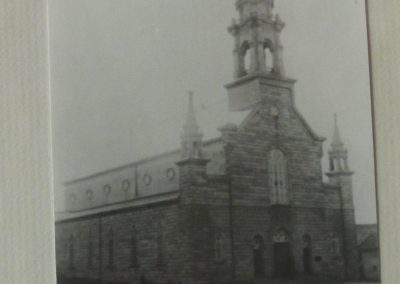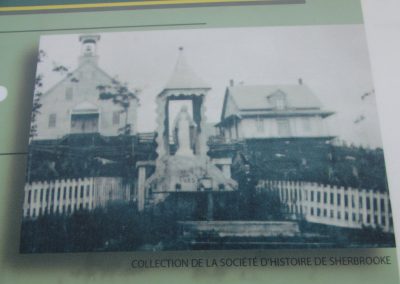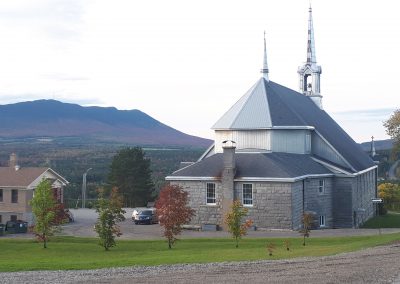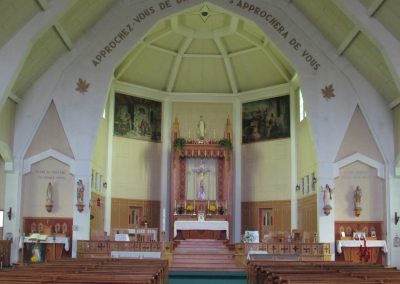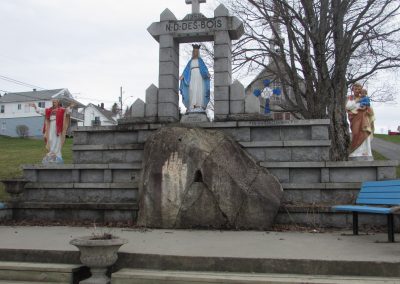The miraculous grotto of Notre-Dame-des-Bois
Repartriation Act:
In the 19th century, thousands of French Canadians emigrated to the United States because of the lack of work. To counter this great exodus, the government of the province of Quebec opened new lands to colonization. On February 23, 1875, the Repatriation Act was sanctioned, in the hope of bringing these poor people back to Canada. “Towards the end of May 1875, the Township of Chesham was officially opened to serious settlement and competent men were charged with marking the site of a church and thus the location of a village. One of these explorers went to Bishop Racine to consult his views. The venerable bishop of Sherbrooke gave his advice and instructions, while manifesting his intention to put the new establishment under the invocation of Mary Immaculate. He insisted on the necessity of taking a site with a good water supply” (c.f. Souvenir Album).
Under the energetic impetus of Jerome-Adolphe Chicoyne, colonization agent, the settlers began to flock first to La Patrie and then to Chesham Township. “After having gone a little on all sides, the representatives of the authority stopped on the side of a gentle slope and lined with beautiful trees. The place seemed, in many respects, to answer the purpose that they were trying to achieve. The question of water remained. Certain plants, which showed here and there, let believe that the ground was not deprived of moisture. The explorers were deliberating on this rather important part of their study, when their attention was drawn to what appeared to be a pile of debris hidden under a thick layer of moss. The clearing up allowed to recognize the presence of a rock emerging from the ground, while at its base gushed a spring with an abundant and limpid course. This last observation put the seal on the definitive choice of the hill, already noticed” (c.f. Souvenir Album). A few days later, clearing and building began.
First mass:
In June 1875, Father Alfred Desnoyers, parish priest of Saint-Pie-de-Bagot and one of the directors of the Bagot Colonization Society, came to the site, accompanying Mr. Chicoyne and his wife. They arrived on the site on June 16 of that year. “The next day, the sky was as clear as a June sun. Father Desnoyers wanted to say mass. It was suggested that he do so on the large stone opposite. An altar was improvised, decorated even with ferns and a few tricolored banners in the trees” (c.f. Notre-Dame-des-Bois, Programme-Souvenir).
Some say that, at the beginning of mass, a strong wind shook the branches and banners around the altar, and the birds sang loudly. Then, at the ”Sursum corda” (let us raise our hearts), obeying the voice of the priest, the breeze ceases to wander through the foliage – the flags stop their graceful undulations, the music of the birds ceases, and an absolute, solemn silence proves that all the voices rise up there, beyond the dome of foliage of this immense temple that nature lends us… During the “memento” the priest’s voice takes on serious intonations full of emotion; he prays to God to bless this newborn parish, its present and future inhabitants” (c.f. Album-Souvenir).

This was the first mass said in the canton, and it was decided to keep the memory of it by erecting a statue of the Blessed Virgin on the stone where it was said” (c.f. Notre-Dame-des-Bois, Programme-Souvenir). The statue was offered by Mr. Chicoyne who, nine years earlier, “had vowed to organize a pilgrimage in honor of the Blessed Virgin, if she would obtain a favor for him” (c.f. Notre-Dame-des-Bois, Programme-Souvenir). His favor had been obtained, but his pilgrimage had not yet taken place. “He therefore took advantage of this opportunity to thank his Queen for the favor granted” (c.f. Notre-Dame-des-Bois, Programme-Souvenir). It was solemnly blessed by Monsieur Victor Chartier, the parish priest at La Patrie, on June 15, 1876.
This event is considered the founding act of the village. From eight inhabitants on February 23, 1875, the number grew to 636 in October 1876. The inhabitants of the village and the surrounding area took the habit of venerating the Virgin Mary in this place and of placing at the foot of the statue flowers picked in the woods. Seeing this devotion in the making, Bishop Antoine Racine, founding bishop of the diocese of Sherbrooke, issued an official decree erecting the Rock of the Virgin as a place of pilgrimage on August 15, 1883. “Since the installation of the statue on the rock, a great number of spiritual and temporal favors have been brought to the attention of the various parish priests who have succeeded one another at Notre-Dame-des-Bois”, reports a 1958 souvenir album.
Miraculous spring:
Very quickly, the spring that gushed out from under the rock was described as miraculous by pilgrims. “In November 1879, Joseph Corriveault, the brother of the parish priest, suddenly declared himself cured of an ingrown toenail which had been causing him terrible pain for some time, after having washed himself the day before with water from the Spring of Notre-Dame-des-Bois” (c.f. Souvenir Album).
Miraculous statue:
According to the testimony of Adéline Stratford, “in July 1880, a man fell from his hayloft. He was paralyzed and could not move on his bed. He was taken for nine days in a row to pray the rosary at the statue of Our Lady of the Woods. On the ninth day, after the rosary, Father Corriveault told him to go home on his feet. And like the paralytic of the Gospel, he got up perfectly healed (c.f. c.f. Souvenir Album).
Healing of Mrs. Stratford’s grandson:
On June 17, 1951, Mrs. Stratford (Adéline Corriveau), who is the niece of Father Ferdinand Corriveau, parish priest of Notre-Dame-des-Bois from 1879 to 1887, obtained a healing for her grandson Harold in front of the statue of Notre-Dame-des-Bois. She left about fifty years ago to live in Millbury, Massachusset. Her grandson, Harold Stratford was born blind. After undergoing six surgeries, he finally regained his sight, but the grandmother is quite convinced that Our Lady has done her part. It was a great favor she granted us,” she said, “but it was still very little compared to the other favor she had in store for us” (c.f. Notre-Dame-de-Bois, Programme-Souvenir). Mrs. Straford says that Harold began having seizures three years ago. The family consulted the best specialists in this type of illness, but without any improvement. In fact, the seizures became more and more frequent. Towards the end, they were occurring at the rate of two or three a week. Since the doctors can do nothing,” said Mrs. Stratford, “let them keep their remedies, and we will ask Our Lady of the Woods to show her power” (c.f. Notre-Dame-des-Bois, Programme-Souvenir). She made the trip with her grandson to Notre-Dame-des-Bois on June 17, 1951. After dinner, while at the Hotel Blais, she said to Harold, who was about to take his remedies: “This is the last pill you are taking; we will go later to pray to Our Lady of the Woods, and she will heal you. As a matter of fact, Harold has not taken any medicine since and yet he has not had a single seizure. I call it a miracle,” added Mrs. Stratford. We had asked for an improvement in Harold’s health, and it seems that she has cured him completely” (c.f. Notre-Dame-des-Bois, Programme-Souvenir).
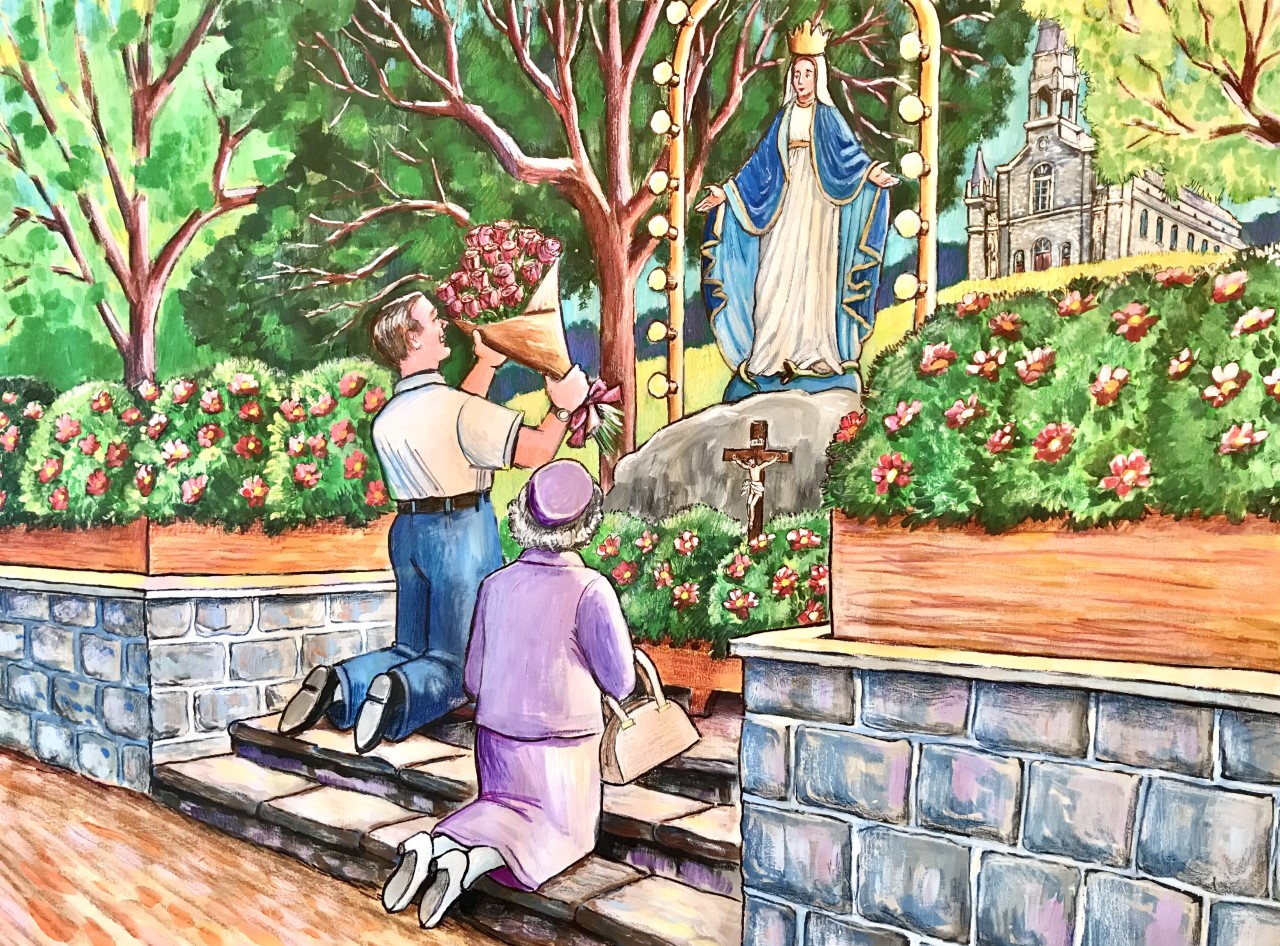
During her visit in June 1951, Mrs. Stratford promised to build a grotto on the grounds of Notre-Dame-des-Bois, if her grandson’s health improved. She kept her word. In 1958, work was done at the instigation of Father Joseph Quirion. A niche for the statue, a granite altar and a granite basin were installed. This work was largely paid for by Mrs. Adéline Stratford.
Sources:
–Album-Souvenir du 75 anniversaire de l’établissement d’un lieu de pèlerinage à Notre-Dame-des-Bois – 15 août 1883.
–Notre-Dame-des-Bois, programme-Souvenir, 1877-1952, pages 62 and 68



